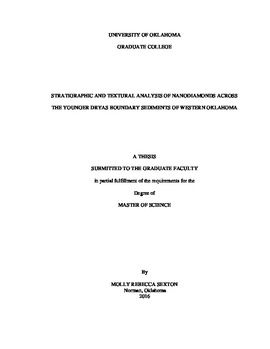| dc.description.abstract | Exposed sediment profiles of the panhandle of western Oklahoma have
previously been shown to contain two peak abundances of nanodiamonds, one dated
approximately to the Younger Dryas and the other from the Late Holocene. The
sediments of the Bull Creek Valley contain numerous Clovis culture artifacts and
megafauna remains that disappeared after the Younger Dryas Boundary Layer.
Firestone et al. have proposed that the reason for this sudden disappearance is a bolide
impact that broke apart in the atmosphere, scattering debris across the world (2007).
Nanodiamonds could be evidence for such an impact. In this study, I examined 12
additional samples collected at the same time as those reported by Bement et al. (2014)
but not analyzed for nanodiamond content using Transmission Electron Microscopy
(TEM). These samples were collected at various locations along the same Bull Creek
valley, Oklahoma, including sediments older than those analyzed by Bement et al.
(2014) and an additional nearby location that crosses the Younger Dryas Boundary. No
nanodiamonds were found in these samples. However, the results may not be indicative
of the true nanodiamond abundance. In a further test, a grid was prepared from a
sediment digest solution shown by Bement et al. (2014) to have a peak abundance of
nanodiamonds. No nanodiamonds were observed in this sample, suggesting that the
nanodiamonds may have a finite lifetime when preserved in an ammonium hydroxide
suspension. Additionally, Raman spectroscopy was investigated and ruled out as a
means of screening samples for nanodiamond content more quickly and easily. Prepared
samples of sediment solution previously confirmed to have nanodiamonds showed no
Raman peaks associated with diamonds, though this could also have been the result of
x
the ammonium hydroxide suspension storage. However, samples of untreated
commercial nanodiamonds also did not exhibit any characteristic diamond peaks,
though possible peaks may have been obscured by heavy fluorescence.
Finally, the samples that were confirmed by Bement et al. (2014) to have
nanodiamonds were divided into groups based on the ages of their sediments and highresolution
(HRTEM) images of them were examined for the textures of individual
grains in order to gain a better insight of how they may have formed. The textures were
categorized as having no lattice fringes, partial fringes, continuous fringes, linear twins,
nonlinear twins, or star twins. The nanodiamond grains in the Younger Dryas
Boundary group had the lowest ratio of linear to nonlinear grains and one of the highest
ratios of star twins to twins, both of which are indicative of a chemical vapor deposition
formation mechanism.
This is the first study to analyze and compare nanodiamond textures from the
same stratigraphic area. The differences found between the older and younger
nanodiamonds suggests that further studies comparing textures across spatial and
temporal boundaries could lead to more definite signatures indicative of their origins. | en_US |
